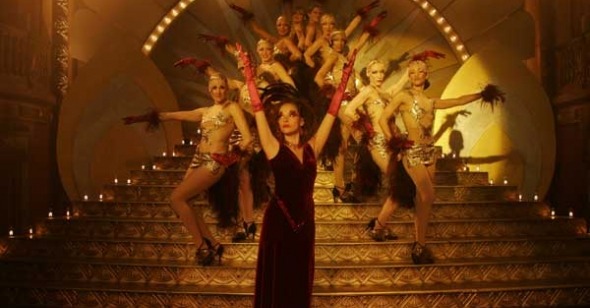Blues Clueless
by Eric Hynes
Dark Streets
Rachel Samuels, U.S., Samuel Goldwyn Films
What do noir, Busby Berkeley, the blues, and funhouse fantasy have in common? As Dark Streets ultimately proves, not much. Aiming for the inspired style warp of Terry Gilliam’s Brazil but landing somewhere in the territory of Cirque du Soleil or Disney’s House of Blues, director Rachel Samuels mashes up genre and chronology while showing little understanding or interest in the integrity of any of her sources. What motivated noir’s high contrast, its cynicism and misanthropy? What motivated the blues’ lament, its horny, smoky suicidal heartbreak Dark Streets couldn’t care less, grafting together tropes despite cultural and aesthetic incompatibility, proud to wear them as layers of shabby chic fashion.
Opening and closing with a bullet to the head, Dark Streets is narrated by a creepy mohawked MC named Prince (L.A. choreographer and performer Toledo) who lays the blues mysticism on thick. “Welcome to the blues,” he says, milking pedal notes from his voice and lighting a darkened room with a burning cig. Cut to an opening credit montage of foggy alleyways, trash-can fires, and oil-slick streets (picture Michael Jackson’s “Smooth Criminal” video tweaked with Sin City pretension), all scored to an overproduced number authenticated by B.B. King himself. The yarn, such as it is, finds dreamy hard-drinking melancholic cabaret owner Chaz (fresh-faced beanpole Gabriel Mann) mourning the death of his father, deflecting the attentions of brassy old-flame Crystal (Bijou Phillips) and surviving prune-faced mobsters. “The blues: once it’s in you, it’s got you,” says Prince. “It had Chaz bad.”
Convinced that dad, an electricity magnate, was murdered, he enlists a reptilian, leathery Lieutenant (reptilian, leathery Elias Koteas) to turn over some rocks. In turn, Chaz hires the Lieutenant’s blonde bombshell protege Madelaine (Debbie Harry dead-ringer Izabella Miko) as the nightclub’s resident chanteuse. Before you or Prince or the somersaulting-in-his-grave Robert Johnson can say, “Don’t dance with the devil,” Chaz falls for Maddie and seals his fate. Original, swamp-glazed ditties sung by Dr. John, Etta James, Natalie Cole, and Chaka Khan blanket the soundtrack, utterly failing to sell an attractive, aristocratic white dandy as a victim of the blues. “Mood” as pose, “dark” as style, and “blues” as a button on a Casio keyboard, this is “American Idol salutes Buddy Guy” caliber culture, complete with Aaron Neville at the mike and Richie Sambora on guitar.
Distractingly shot from beginning to end with “swing and shift” lenses that distort portions of the screen, “Dark Streets” literally lacks depth. Samuels and DP Sharone Meir leave the viewer no choice but to dwell on woozy, toggled surface, granting only secondary attention to scene, set, story, performance, or even composition. Even if one were to appreciate the novelty of the technique, its expression often lacks clear motivation, giving all manner of dramatic or expressive set-ups the same phantasmagoric treatment: a two-shot is sabotaged when half the screen (the talking half) sinks into vaselined distortion; a Busby-cribbed dance number is similarly robbed of its necessary symmetry; a drunken haze sequence is indistinguishable from convex sobriety.
In a film this airless and busy, the best an actor can do is hit his or her marks and avoid embarrassment. Yet Bijou Phillips manages something more, bringing an unpredictable desperation to a thankless third-wheel role and performing the lone standout song, a high-pitched bit of naughtiness called, “Let’s Be Nice Some More.” Alas, at the film’s center drowns Gabriel Mann, an actor cursed with a reedy, Edward Norton voice, and the carriage—and charisma—of a Slim Jim (though one with a nifty William Powell stache). Toledo, who’s shockingly the film’s sole black principal character, has fierce song and dance numbers that might work on their own, but here they comprise an odd and distracting undercard, yet another disparate element in the cacophonous mix.
Temperance and depression-era nostalgia, Art Deco bric-a-brac, circus exotica, and suburban burlesque all filtered through musical theater and white fantasies of black mystical wisdom, Dark Streets is theme restaurant Americana: overstimulated, overmediated, and overstuffed.
